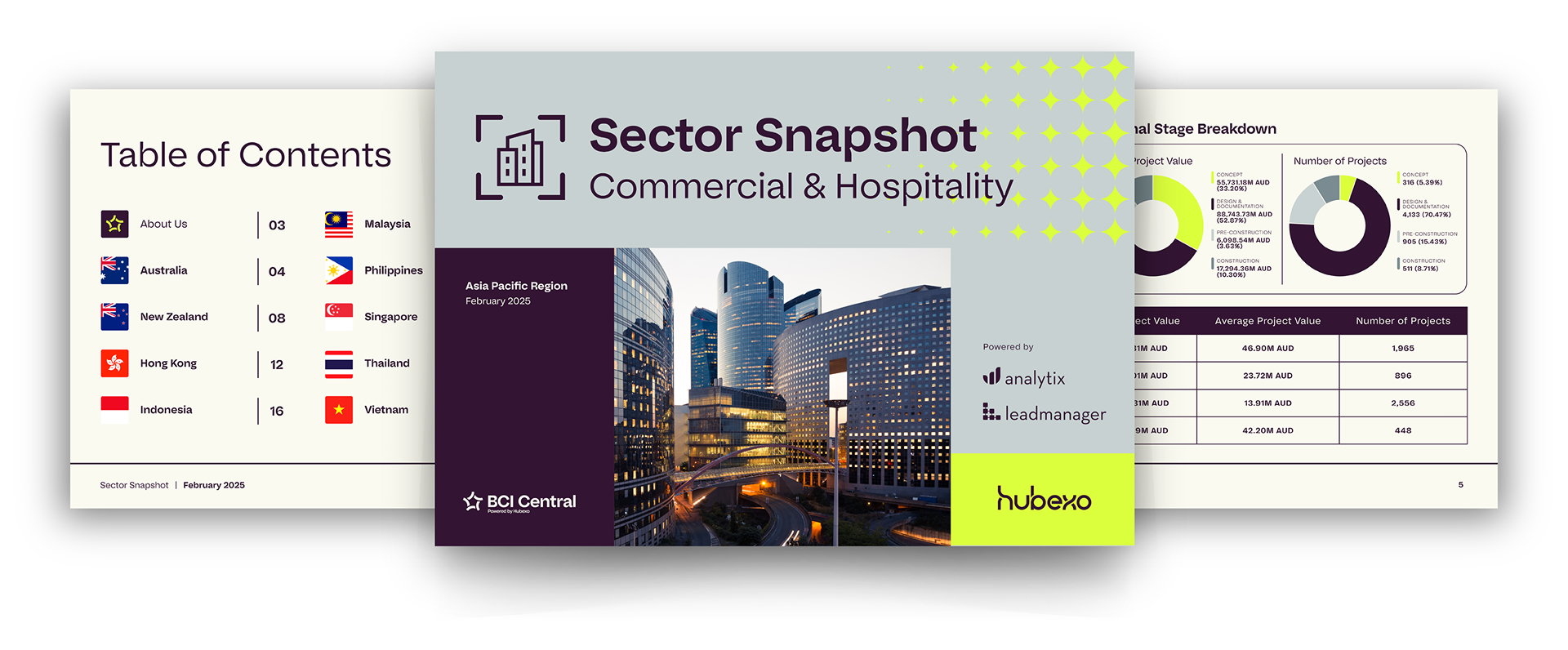- Home
- >
- The Top Five Risks Influencing the Australian Construction Industry in 2024
The Top Five Risks Influencing the Australian Construction Industry in 2024

The Australian construction sector is cautiously optimistic as the industry emerged from a year of remarkable volatility. However, the next 12 months bring a slew of headwinds and challenges that demand attention.
After a year spent under the shadow of rising interest rates, major Australian construction companies have faced inflation pressures, rising wages and shortages of skilled labour and materials, leading to increased costs strongly felt throughout 2023.
Despite a high volume of work filling construction pipelines, the industry continues to tackle the challenges of a post-pandemic Australia.
In the cautious landscape of Australia’s construction industry, many are pondering: What is on the horizon for 2024? Will construction gain momentum or hit the brakes? Will inflationary pressures ease and construction costs find equilibrium?
To answer these questions amongst many more, our annual report, the BCI Construction Outlook, offers a comprehensive overview of project activity and key considerations for the upcoming year.
Analysing BCI’s pipeline data and industry insights, the report monitors key building sectors and project regions from late 2021. Construction forecasts provide a comprehensive understanding of industry trends for the upcoming year.
Respondents included RSHP Managing Director Avtar Lotay and Associate Partner Torsten Burkhardt, SCLspec Head of Specification Jon Atkinson, SMFA Senior Architects Sally Stansborough and Sarah Swincer, Deicorp Executive Manager of Corporate Communications Robert Furolo, Hutchinson Builders Director Jack Hutchinson, Grimshaw Principal Benjamin Donohoo, Kapitol Group Directors David Caputo and Andrew Deveson, Sammut Group Managing Director Allen Sammut and Growthbuilt General Manager Adam Ashcroft.
5 Key Risks Shaping the Australian Construction Sector
Here are five key risks influencing the Australian construction industry extracted from the latest edition of the BCI Construction Outlook.
- Surge in deferral rates underscores mounting challenges
- Labour shortages top challenge chart
- Australia’s housing crisis deepens
- Sustainability a necessity, not a luxury
- Escalating cost pressures demand rethink
Surge in deferral rates underscores mounting challenges
Early-stage project values have declined since peaking in Q4 2022, but the current trend shows a significant increase in project proposals towards the end of 2023, replenishing the supply for the next year and sustaining high activity levels.
Nationally, investments in the community and public buildings sectors are significant contributors to early-stage project values in Q3 2023. These sectors include community and cultural, education, health, legal and military, and sports and recreation projects.
Deferral and abandonment rates exhibited a notable trend, diverging until Q3 2023. Abandoned projects rose from Q4 2022 to Q2 2023, influenced by escalating construction costs impacting timelines. By Q3 2023, residential, commercial and hospitality sectors nationally recorded higher abandonment rates than deferrals.
While abandonment rates appear to be on a downward trajectory, the simultaneous rise in deferral rates underscores the challenges confronting Australian construction firms and business owners.
Anticipating a robust year ahead, project commencements from Q4 2023 to Q3 2024 are expected to significantly increase in value, reaching a peak in Q1 2024.
The construction forecast for Q4 2023 showed a substantial surge in the number of construction projects, nearly doubling from approximately 3,000 in Q3 2023 to over 6,000. This forecast hints at a potential boom in construction activity across all sectors.
“We’ve got our hands full; we need to focus on delivering these jobs,” Jack Hutchinson, Director of Hutchinson Builders, told BCI Central.
Labour shortages top challenge chart
Labour shortages were labelled one of the key risks by builders surveyed in this year’s outlook report.
In the past few years, builders have grappled with significant challenges, from material shortages and soaring costs to the added complexity of uncertain availability of skilled labour, impacting their on-site work scheduling.
Currently, the concern of labour shortages looms prominently in the thoughts of most Australian builders. A staggering 90% of builders surveyed have identified this issue as a key risk to their business.
“[The lack of] labour and shortage of skilled workers represent the biggest risk to projects and risks like these need to be priced into feasibility of projects,” Robert Furolo, Executive Manager – Corporate Communications at Deicorp, said.
The opinions among the respondents varied regarding how soon the labour constraints would improve.
Adam Ashcroft, General Manager at Growthbuilt said the difficulty in finding skilled labour had increased pressure to retain talent in the business.
“Over the next 12 months, the scarcity of subcontractor labour will remain a challenge, impacting our ability to deliver projects within stipulated timelines,” Ashcroft said.
Australia’s housing crisis deepens
In the face of an unprecedented housing crisis, Australia struggles to cope with the surge in migration levels. This surge has led to an ambitious target of 1.2 million homes being built over the next five years.
In 2024, homebuilding faces its slowest pace in over a decade due to rising costs. Doubts surround government housing targets. The surveyed professionals suggest easing regulations through government intervention, focusing on reducing interest rates. Developers propose increasing land releases as a solution.
Benjamin Donohoo, Principal at Grimshaw, advocates tackling the shortage by strategically building along new transit corridors, growth areas and activity centres.
“This would provide incentives for developers, ensure height and density is in the most suitable locations whilst achieving design excellence,” Donohoo said.
Although the government has allocated $3.5bn, the industry still feels there is a need for policy review and an assessment of the “dysfunctional planning system”, as one respondent phrased it, to allow quicker delivery of a broader range of housing types.
“Above all, [we need] a housing typology that allows for low-cost, low-service, low-fitout, shared facilities that can grow later into a fully titled and fully serviced property asset,” Jon Atkinson, Head of Specification at SCLspec suggested.
Several respondents believe that the emerging build-to-rent (BTR) sector will influence the market. This sentiment is reinforced by the growing participation of major asset managers and super funds strategically deploying their capital within BTR.
Sustainability a necessity, not a luxury
Australia experienced extreme heat in the latter part of 2023, making it the hottest year on record. Temperatures soared to 43.5°C in some areas of south-east Australia, underscoring the sluggish global progress in curbing emissions.
The Australian construction industry is embracing sustainability to cut its carbon footprint. Respondents highlight a sustained emphasis on energy-efficient products and low water consumption. Low embodied carbon measures surged from 24% to 38% year-on-year.
Despite this positive trend, rising material costs due to inflation present a challenge, creating tension between environmental goals and practical business considerations.
Sally Stansborough and Sarah Swincer, Senior Architects at SMFA, pointed out that the prevailing industry mindset often treats sustainability as a non-essential luxury rather than a fundamental requirement. This perception has led to cost-cutting measures in construction practices.
However, Stansborough and Swincer emphasised that this perception is currently being challenged and reevaluated.
While there is a positive movement towards sustainability, challenges in the Australian construction industry include a lack of focus, misdirection and a lack of common understanding, resulting in a watering-down of key environmental goals.
Escalating cost pressures demand rethink
Four of five property developers warned that early cost escalation is the key risk looming over the next 12 months, closely followed by contractor insolvency.
Escalating inflation, material costs and labour shortages have created a tense environment, exerting sustained pressure on fixed-price contracts and margin targets.
“Getting a job, getting the funding, getting the development approval, getting all of that is a risk and it will always be a risk—especially planning risk and funding risk,” Allen Sammut, Managing Director of Sammut Group, said.
“But then you get to that point and you’re ready to start, you’ve now got to find a builder [and] what’s the builder going to price [the project] at?”
Construction insolvencies in Australia hit a nine-year high in 2023 as rising costs and fixed-price projects squeezed companies.
BCI Chief Operating Officer for Australia and New Zealand, Ashleigh Porter, said solvency in the sector is likely to remain an issue over the next 12 months and could worsen if interest rates rise further and the economy slows.
“Amid these challenges, winners and losers will inevitably emerge,” Porter said.
“Well-capitalised builders are positioned to expand, seizing opportunities left in the wake of failed firms, a trend already witnessed in 2023. The landscape promises to be challenging, but it’s one where resilience and financial strength can turn adversity into opportunity.”
Want to learn more about the current state of the Australian Construction Industry? Dive deeper by downloading this year’s BCI Construction Outlook.






